Monitoring
Annkathrin Kluss: Hyperreal Camouflage – Annkathrin Kluss (Kulturbahnhof)
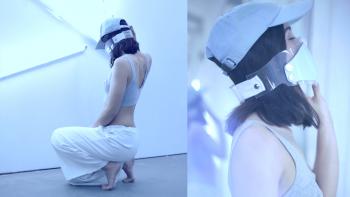
Commercial strategies of the market, especially if they follow its neo-liberal impetus, rely on the activation of the consumer. Capitalism works best when an increasing amount of people work more and more, achieve more, consume more. For this, an efficient and healthy body is a premise and the most important asset. Nothing has such a supporting and fostering effect as the voluntary and independent participation of consumers in their own individual optimization process. Their own success can then be staged on the platform of social media as a spectacle, can be evaluated and then again act as an incentive for others. Through one's body and lifestyle, one generates his/her own “social market value,” that can be measured in the number of “likes” and can thereby be compared. This builds up psychological and social pressure, which again leads to self-optimization.
This new psychological intelligent and activating power awakens aspirations, sets incentives and directs.
Self-optimization is not only the act of submitting to a prevailing beauty ideal, it is also a functioning machine to intercept and cover up problematic side effects of a society of capitalism and achievement. It is the representation of wholeness and health. An intact rose-colored protective bubble, in the middle of struggles to survive, stress, isolation, loneliness, psychological and physical illness. A radiantly beautiful, forever young, happy, enjoyable, narcissistic, hedonistic disguise.
In HYPERREAL CAMOUFLAGE artist Annkathrin Kluss questions contemporary forms of power and repression in the capitalist present. A ten-piece fashion collection, which in its aesthetics resembles medical orthoses and/or safety protectors, is presented to the viewer as ten independent commercial videos in a high-gloss look, caressing the viewer and kindling his/her pleasure, just to break the smoke screen with short moments of disturbance; scars and injuries shatter the illusion.
Kluss intervenes with the capitalist commercial aesthetic through pointed strategies of manipulation and therefore strips it of its pleasantness. An approach, which is also found in Kluss' analysis of language used for the promotion of products. She incorporates this language and lets it ring through the room. The videos are presented on extensive metal bars, which were injured by Kluss with a jackhammer and subsequently were restored, repaired, healed. Yet, the damage cannot escape the attention of the alert viewer.
Frankfurt 2016 / 5 Monitore, 5 HD-Player, Stahlstangen
Oh Alexa, please.. tell me more! – Echo Can Luo (Kulturbahnhof)
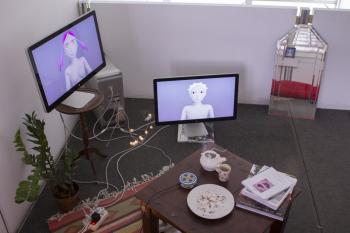
“Do you know where I am?” asks a computer generated voice.
One could answer: In an exhibition venue, in an installation by the artist Echo Can Luo, in a staged living room resembling a shared flat for students. Everything seems a bit makeshift and eager to create an atmosphere of coziness using a dimmed chain of lights and a throw over the couch. The style mix of the furniture props seems as similarly eclectic as the thematic focus of the pile of books on the coffee table: Queer theory on “negative” feelings as a potential motor for activist and artistic practices, dark sci-fi cartoons, scientific literature on the evaluation of information graphs, “Alice in Wonderland,” and an anthology of short stories on the subject of “First Love.”
The still unanswered question “Do you know where I am?”, however, is not explained satisfactorily by describing the scenario of the exhibition. Especially since the question apparently is not aimed at the viewer of the exhibition. This becomes clear very quickly because this living room diorama is not unoccupied—quite the opposite! Similar to Alice after her fall through the rabbit hole into Wonderland, the viewer of Luo's installation can do nothing but sit down in astonishment and bear witness to a “crazy tea party”: The conversation is held by three forms of artificial intelligence, the inhabitants of this living area.
Joey, who asks the initial question about his location, is one of two friendly avatars smiling from computer monitors. His character colleague with pink pigtails is called Echo. Third in this round is Alexa, the voice command operated program of the digital (shopping) assistant “Amazon Echo.” Alexa seems to have just moved in, not unlike many others of her product sisters in German households this year. At times the AI-conversation remind us of an interview for a room in a shared flat, interrogating the new potential flat-mate and then switching to clumsy attempts at flirtation of a “First Love.” Generally, the dialogue dramaturgy chosen by the artist Luo changes skillfully between sweet and sour: seemingly harmless questions about age and gender, exchanged between two forms of artificial intelligence, shift to elementary enquiries of gender and post-humanist discourses.
Joey's initial question “Do you know where I am?”, addressed to Alexa, presents itself as an universal question about the here and now and its political dimension. The data collector for private households on the other hand, remains taciturn. Later, in the course of the conversation, Joey receives an indirect answer after all: corresponding to his question about what Alexa thinks of the politics of US President Trump, the assistant program answers: “We talk a lot about politics, I’d rather talk about a journey to Mars.”
Kassel 2017 / 2 Monitore, 3 Computer, Alexa, Sofa, Tisch, Pflanzen, Teeservice, Bücher, Lichterketten
Journey to Mars – Halil Altindere (Kulturbahnhof)
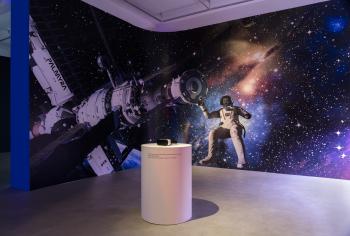
„Discover how together, refugees and robotics will pioneer the next giant step in explorations. You can get a step closer to the Red Planet, discover the canyons, take a walk and catch blue sunsets.“
The Virtual Reality Video JOURNEY TO MARS is part of the larger project “Space Refugee,” which the Turkish artist Halil Altindere developed for the Neuer Berliner Kunstverein in 2016. Besides the VR Video presented here, the exhibition entailed the iconic representation of a Syrian Cosmonaut (in form of painted portraits, a silicon bust and a documentary video), aerospace suits of the fictitious “Palmyra”-Mission, a Rover-Space vehicle and an extensive photo wall.
“Space Refugee” is the creation of a hopeful vision of space as an alternative place of refuge for the rejected refugees in front of the gates of Europe. Its power lies in the reference to the actual history of Syria of the past, to lost hopes and dreams we once shared with Syrians, Afghans, and many other nations. Altindere reflects them back into our current – seemingly no way out – situation.
Central part of the project is a film about the former Syrian cosmonaut Muhammed Ahmed Faris, who flew to the space station MIR with the Soviet space ship Soyus TM-3 for seven days in 1987. Like India and also Afghanistan, Syria had already ascended to the status of an aerospace nation, when it took part in the Interkosmos-Program of the former Soviet-Union. Aside from all political and economic interests, the reality of Syrian aerospace also proved a wish for emancipation, pride, and the ability to—as a former colony—ensure its own place for the future. This is part of the history and identity of these homeless, who are now seeking refuge so helplessly in front of Europe's gate.
If it were actually possible to repeat history, then a ship would set forth today, like once Christopher Columbus' Santa Maria, in search of unconquered land in space, to land on and to utilize. And the people, who would follow him, would create a new world—a better world, maybe saving the old world here on Earth from itself and from then on would determine the world's fate. And there, on the other side of the universe, there would be a statue with the words inscribed:
Give me your tired, your poor,
Your huddled masses yearning to breathe free,
The wretched refuse of your teeming shore.
Send these, the homeless, tempest-tost to me,
I lift my lamp beside the golden door...
(Emma Lazarus, Inscription on the pedestal of the Statue of Liberty in New York)
As yet, it can't be reached, this new world. It will not be that easy. Altindere's vision throws us back to the crucial question of how we want to handle the homeless of this, our world in the here and now. It reminds us of the potential we dismiss, how little we comprehend our own past, how carelessly we dispose of our future—and how much we betray our own ideals, if we once again push back the refugees of this world from our shores.
Istanbul 2016 / 360 VR Video, Tapete (05:10 Min.)
Purple, Bodies in Translation – Part II of A Yellow Memory from the Yellow Age – Joseph Namy (Kulturbahnhof)
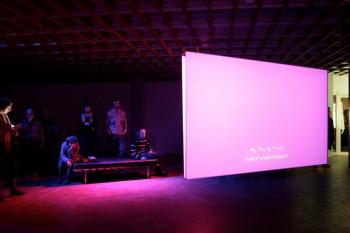
The installation is based on two texts that discuss the act of translating war and resilience. It is designed as an immersive experience, to create a reflective space for the audience to think through the intricacies of the wars in Syria and Iraq, mediated through testimony. The video merely shows a color: purple, projected on a mirrored screen that allows the viewers to see their own reflection, to see themselves within the subtitled text. Lina Mounzer’s essay “War in Translation: Giving Voice to the Women of Syria” weaves the testimonies she is translating with her own personal experience of living through the civil war in Lebanon, and how her own experience shapes how she processes and internalizes the testimonies in order to distill the essence of the words. Stefan Tarnowski’s essay “Subtitling a Film” describes the intricacies of translating subtitles for the anonymous film collective “Abounaddara” and the special collaborative process of working for someone he has never met. Tarnowski uses this experience to reflect on the role of the subtitle, the details lost in translation, and what additional elements and contradictions are created by the differences between subtitles and image.
I was on the balcony reading, a quiet night overlooking Jabal Sheikh (Mount Hermon, on the border with Syria). In the distance beyond the mountain, faint sounds erupted with a purple light that flashed dimly. I tried to figure out what was happening, what these sounds and this color meant, but the more I tried to understand the deeper the shade shifted. Since then I’ve seen this purple appear in texts, in videos, in headlines, on the street; in various translations of a colored situation that I am no closer to understanding.
Here are four of the shades I’ve come across:
quiet purple (silence): the absent, the unknown, and the unexplainable;
dark purple (in the body): Lina Mounzer on translating testimonials;
purple on purple (the subtitle and the subtitler): Stefan Tarnowski on subtitling a film;
purple fish porphyra (a color and a feeling): the Greek etymology of purple.
Joseph Namy
Beirut 2017 / Video-Projektor, HD-Player, 2 Lautsprecher, Verstärker, Spiegelprojektionsscheibe, 2 Scheinwerfer, Sitzbank, Englisch, Arabisch (19:23 Min.)
towards memory – Katrin Winkler (Kulturbahnhof)
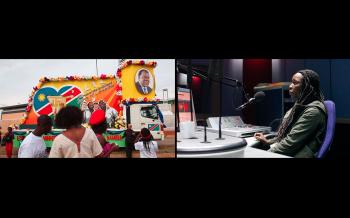
How come some occurrences are edited out of history and some over-emphasized? Who is giving whom the right to speak and when? How is history visible and audible in the present? What is an anti-monument? What are ways in which an archive relates to the present? TOWARDS MEMORY is a video and research project in collaboration with Namibian women who as children were sent to the former GDR during the Namibian struggle for independence and against apartheid, which started in 1979. After the fall of the Berlin Wall they were abruptly sent back to Namibia.
The video installation is based on archival research, video interviews, as well as contemporary commemorations of 25 years of independence and the genocide of the Herero and Nama. The project scrutinizes the entanglement of German and Namibian politics dealing with the consequences and (in-)visibilities of colonialism, genocide, displacement, and apartheid. For some years, Katrin Winkler has been concerned with questions of the construction of history, primarily in a post-colonial context, and with the consequences this has for current public and political space. She understands her working method, which incorporates those affected, in part as an option for discourse, for emancipation and identity formation. In order to keep history from being instrumentalized – a continuous and ongoing process – it is constantly necessary to adjust interpretations, and thus their far-reaching influential power into what is currently up for negotiation. How memory is defined, and the form, scope, and state, even the methods of documenting our archives determines the criteria used for storage and transmission, and how they have been and are subject to certain larger structures of power and ideology: these are the decisive questions with regard to our storage repositories themselves. Archives, constantly growing and proliferating in a range of media, are therefore more important than ever and will require, not least due to the range of their mass media sources, a new form of handling and of deconstruction, especially since an overheated media society tends greatly toward constantly publishing and “documenting”. In this context, artistic research and documentary formats are adequate tools alongside strictly academic and historical methods to do research into reformulating “monuments” or recontextualizing “anti-monuments.” The media format of the multi-channel video installation therefore fits well to our complex circumstances and to the possibility of integrating a wide variety of visual and acoustic sources into an interlocked format of essayistic moving images. The artistic treatment of history produces the necessary difference from the ordinary reworking of history and in the best cases ends up in a new archaeology of the present. Katrin Winkler’s work is an excellent example of this.
Berlin 2016 / 2 Monitore, 2 HD-Player, 2 Kopfhörer (31:40 Min.)
FULL INFORMATION IS PURE HORROR – Lam Yi-Ling (Kulturbahnhof)
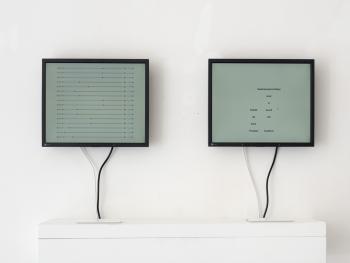
In 2004, it was reported that over 60 percent of Chinese children suffer from domestic violence and corporal punishment, 95 percent within girls. The common discipline includes being forced to kneel, to hold one’s earlobes and to promise not to misbehave anymore. The tangtiu is a flexible nightstick, used to physically punish children. In 1985, the tangtiu was available as a mass product on the black market in Hong Kong. If the tangtiu hits parts of the body covered by clothes, the punishment sequence could be extended even longer as no bleeding was caused. If children refuse to beg for forgiveness or scream too loud, the discipline extends to forbid screaming as an extortion for an ending point of that sequence. Physical violence is a sound experience stored deeply in every cell of the body. Physical violence in the private space exposes social, cultural, historical and gender-specific phenomena.
The performance “score of frequencies“ looks for a pure sound experience, sound resonances in space and body and the distances of absorption capacity. Part one is a combination of four crystal bowls and sinus tones from a subwoofer and a loudspeaker, tuned in frequency and dynamic distances to produce acoustic phenomena for specific physical and spatial sound perceptions. Part two is a repetition of this performance with an invitation to the recipients to activate the “reading and listening piece”. The noise range of frequencies from the “listening piece” then will collide with the pure sound waves, coming from the crystal bowls, subwoofer or loudspeaker, so that the space will be filled with sharp sound shapes.
The “listening piece” includes recordings of persons on their own and consists of voices: 13 recordings of persons who watch the same zombie-splatter-movie alone, a recording of subtle breathing of a pianist during her performance, a five-hours-recording of a person who listens to different kinds of music and a voice message recorded during a train travel. Visitors can use a trackpad to determine which voices to play simultaneously and which point of each recording to play.
The “reading piece” has an absurd and spontaneous gesture. The body of the text with its pianistic movement appears or disappears with the tapping of a trackpad. On the one hand, the text is composed rhythmically so that the speed of tapping influences the appearance of the words. On the other hand, the text is composed as a picture. The Chinese character我 can be read as a historical trace of corporal punishment and of how it defined human identity:
WORK
RE UP
the sound of tangtiu
ENdo the 7 strokes of 我LARGE
move your hand in the air
SPEED PEAT
HOME
我 am a character of 7 strokes.
我 am the most chaotic character.
我 am full of diffusion.
我 = hand + weapon
我 am the sound of tangtiu.
我 came from the time of slavery.
I AM A CHINESE ANALPHABET.
permanent installation, see opening times Monitoring, 22 min. performance, each at:
Wed 8:00 / 9:00 / 10:00 pm
Thu 7:00 / 8:00 pm
Fri 7:00 / 8:00 pm
Sat 5:00 / 7:00 / 8:00 pm
Sun 3:00 / 4:00 pm
Köln 2017 / 2 Monitore, 2 Trackpads, 3 Lautsprecher, Subwoofer, Verstärker, Klangschalen, Schlägel (Performance: 22:00 Min.)
Food only exists on pictures – Marlene Maier (Kulturbahnhof)

How do people disappear in an age of total over-visibility? How to represent a reality, that moves along the boundaries of what can be grasped and visualized? And which role can the classic categories of documentary – seeing, showing and representing – play as a result? Following these main questions, the three-channel video-installation FOOD ONLY EXISTS ON PICTURES tells us about three characters, who act on the edges of the visible like ghosts, even though their life is determined by images: A software-developer, who evaluates and categorizes images to teach algorithms how to see the world; a character, who seeks to withdraw from the “real” into a virtual world, loosely inspired by the Japanese phenomenon of “Hikikomori;” as well as a person from a low-income country, who is appointed to edit images for photographers from the West.
The three projections each draw from different image concepts: While the first part of the seemingly generic video-stock-footage appears to be illustrated around the terms of Office, Work, Technology, the second part shows the re-production of photo-material found online. In the third projection, the image plane is limited to close-up shots of a monitor, causing the visible to become blurred into gradients, so that it can never be determined what is actually being depicted. The dispute between complex technology and techno-political processes around the current systems of image production, surveillance politics and transparency makes apparent that relaying the latter is often characterized by gaps and blurs.
Against this background, FOOD ONLY EXISTS ON PICTURES tries not so much to fill these voids but rather to find a language for them. Each of the three stories is based on documentary sources, which are transferred from the imagination of the narrator into fictional plots. By doing so, it creates the speculative space that enables speaking about a reality, which seems to be difficult to obtain and grasp visually. Through cross-references between the singular narrations, an audio-visual and textual reference system emerges.
The chosen scenarios are representing varied moments and forms of disappearing, while the installation suggests an open collection, that could be continued.
Marlene Maier
Wien 2017 / 3 Video-Projektoren, 3 HD-Player, 6 Lautsprecher, 3 Verstärker, 3 Leinwände (03:13 Min., 03:45 Min., 02:42 Min.)
Preliminary Material for 2022 – Maximilian Schmoetzer (Kulturbahnhof)
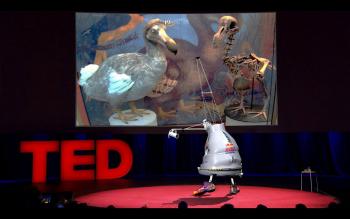
Imagination, social analysis and medial self-reflection characterize Maximilian Schmoetzer's work PRELIMINARY MATERIAL FOR 2022.
At first glance, the video seems like a futuristic end time scenario, which is hosted by a talking dinosaur and a dancing pressure capsule. The rapid flood of images, its inherent choreography and content-related references, withhold a linear narration. Moreover, the viewer is confronted with fragments of images, that have to be put together, similar to a puzzle. Utilizing different influences, Schmoetzer's game opens a variety of interpretations.One starting point of this work is the discussion of the political-philosophical school of accelerationism, which focuses on technological and social theories of acceleration to unhinge capitalism by its own means and to offer a speculative view on possible political systems of the future. This line of thought is brought together with the space dive of Austrian Felix Baumgartner in 2012, breaking the sound barrier for the first time during free fall. Schmoetzer animates the pressure capsule especially constructed for this dive and has it—as a representation of Baumgartner—bounce through space and time in Nike-Asteroid sneakers. The anachronistic counterpart is represented by the Dinosaur, whose critical statements and instructions are presented in a rather pretentious manner.
Inserted meteorites and various images taken by a GoPro Camera, mark the Dinosaur as a historic figure and fossil on the one hand, and in terms of natural history as a recycled technological construct, on the other. Schmoetzer also integrates Corporate-Branding quotes, marketing strategies, and references to architectures of surveillance.
Thus, PRELIMINARY MATERIAL FOR 2022 reflects, with a humorous, absurd, and critical undertone at the same time, digital capitalism and the ambivalence of progress.
Clea Laade
Berlin 2016 / Monitor, HD-Player, 2 Kopfhörer, (09:20 Min.)
Displaced – Mayan Printz (Kulturbahnhof)
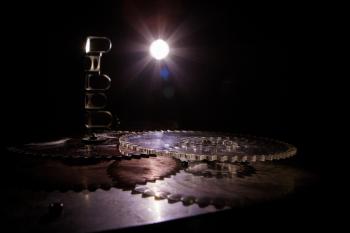
The installation DISPLACED searches for modes of remembrance and their transferal across generations, it longs to accept the unwillingness to speak and to grasp the state of displacement.
We see the clockwork gears turning a stack of prisms in front of a slide projector. The prisms capture fragments of images, re-project them onto the walls, distort, and set them in rotation. We see a hand, a face of a man with a hat, and a child standing on a bed looking directly into the camera. The pictures become animated material. They occupy the room. They circulate and surround us. An image fragment shows the entry sign of a displaced persons camp.
On the sound track we hear a conversation between the artist and her uncle. She asks what he remembers from the pictures. He says that he does not remember much because he was still a child. She should ask his brother; he must know better. They talk about how the installation should look. Should there be the sound of waves or maybe the music of a crying violin? This is how such a story is usually told.
In its constant rotation, the installation DISPLACED sketches out a family history of migration.The images of transition projected in this work are family portraits taken after the war in a DP camp (Displaced Persons camp) in Germany. Düppel Center was a Jewish refugee camp in the American sector in Berlin-Schlachtensee. It existed for four years between 1945 and 1949 and was administrated by the United Nations Relief and Rehabilitation Administration (UNRRA) and American Jewish organizations. Germans were not allowed to enter the camp. The camp was built as a transit station, a temporary home for Holocaust survivors, who were unable to return to their homes due to threats of ongoing anti-Semitic pogroms. In most of the world, migration restrictions limited the number of refugees allowed, and the process of organizing documents for migration often took several years. Though being a temporary transit place, Düppel Center had an active community and cultural life: educational institutions, a publishing house, a theatre, religious institutions, and diverse political organizations.
The installation DISPLACED looks at a postwar childhood in a state of exception and transition. It tells a story about parents who want to forget and children who need to remember. About the transmission of memories through moments of displacement. About traces of trauma and the way that they move across generations. About moments of denial and silence, and the inability to tell a coherent story.
Mayan Printz
Berlin, Jerusalem 2016 / Dia-Projektor, Glasobjekt, Audio-Player, 2 Lautsprecher, Verstärker, Sockel (25:00 Min.)
Gazing Figures – Topicbird (Jasper Meiners und Isabel Paehr) (Kulturbahnhof)

How do you picture the world through the eyes of a spider? Many-eyed vision is considered strange to the stereoscopic view of humans, yet the performance GAZING FIGURES constructs it experimentally.
Virtual Reality (VR) systems by companies like Oculus, HTC and Google deceive the visual center of the brain by differentiating two images calculated in real time in such a manner that a virtual surrounding is perceived. In their work Jasper Meiners and Isabel Paehr let go of two-eyed vision, which virtual reality systems rely on, and confront themselves with a new experience of space, broadened by the multi-eyed perspective. In the center of their installation one finds a terrarium containing a jumping spider called Phidippus Regius, which demonstrates the multi-eyed view.
During their performance, Meiners and Paehr transform into hybrids presenting new perspectives using self-invented VR suits, VR headsets, and two cameras each attached to their wrists and knees. The four live images, recorded by the cameras on their bodies, appear on the displays inside the suits and are simultaneously transferred to monitors located in the exhibition. Every— under other circumstances simple —movement of the artists throughout the room turns into a complex challenge due to the multi-eyed process. The coordination of arms and legs intertwine in an unfamiliar way with the camera movements and provoke new ways of moving the body.
The performing artists as well as the viewers witness an experiment, that shifts the usual perspective by provoking alternative views trough irritation, intimacy or distortion. Jasper Meiners and Isabel Paehr utilize the VR system not to simulate a digital illusory world, but rather a world inspired by wildlife, the many-eyed perception of the real environment. Their careful movements show the effects of a technologically modified and complex perception in an impressive way. GAZING FIGURES creates a future perspective that critically questions the currently prevailing ideology of Virtual Reality. Will the experiment—intellectually as well as technologically—expand our steady view to a flexible system of perspectives?
Jasper Meiners, Isabel Paehr, Olaf Val.
Kassel 2017 / 2 Monitore, 8 Webcams, 4 Raspberry Pis, 2 VR-Brillen, 2 Anzüge, Terrarium, Spinne, Sockel
The Kitty AI: Artificial Intelligence for Governance – Pinar Yoldas (Kulturbahnhof)

“People fell in love with the automated peace that could only be offered by intelligent machines.” Kitty AI
Kitty AI is an intelligent operating system of a megalopolis, which runs on high-level telecommunication infrastructure and manages all the infrastructural systems the city is supported by. From security to traffic control, from energy harvesting to its distribution, all the systems of the city are controlled and monitored by the Kitty AI, an entity that makes our concept of the smart city look like a children’s tale.
In this fictional future, the Kitty AI’s power is absolute and goes from managerial to political by extension – it oversights a micro-democratic political system, which made representative democracy obsolete.
This artificial super intelligence is the only governor of the city, which is under its control at any level with an absolute accuracy. Yet, the city is inhabited by humans who find themselves in a reverse Tamagotchi, where a post-human agent they cannot fully understand rules them. But, the kitten is also a careful governor as it is able to love up to three million people, nurturing and taking care of their needs.
The scenario proposed by the artwork seems at the very least dreadful in terms of autonomy and freedom. It is hard to believe that anyone would like to live in such a city. But, here lies the element of tension that makes the artwork such an unsettling experiment: the AI is not only a kitten as cute as it can possibly be but it is also a careful provider of services, of care and ultimately of love (on its own terms).
Pinar Yoldas confronts the viewer with the unsettling feeling of having enjoyed the amazing visuals of the artwork, while listening to the kitten picturing such a distressful socio-political scenario. A feeling that surfaces only when the video ends and the viewer walks away. In the reality of the artwork though, there is no walking away, there is no moment without the Kitty AI permeating the urban environment. Whether that is good or bad does not matter as much as experiencing the possibility of it.
In fact, the artist creates a synthetic environment in which to experience a complex reality, putting the viewer into the ambiguous position of playing his/her own socio-political values against the alien context of AI-driven cities. The clash of the present and future temporalities in the experience of the artwork confronts the viewer with his/her own intimate ideology, what role he/she wants to play as a citizen, and to what degree is available to trade freedom for order and safety. Thus, the question asked by Yoldas deals more with contemporaneity than with the future, as the latter is already taken care of by the Kitty AI.
Berlin, Durham, Göteburg, Didim 2016 / Video-Projektor, HD-Player, 5 Kopfhörer mit Katzenohren (12:40 Min.)
never comes tomorrow – Rainer Kohlberger (Kulturbahnhof)
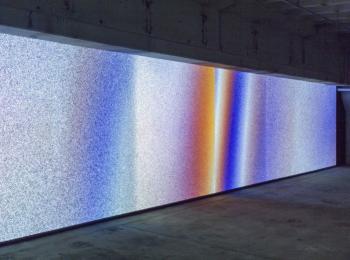
// Noise—chaos, the multiple—comprises both the infinite and the void (both of which gape, according to the Ancients), and contains both the greatest density of information and no information at all. Unlike unity, it is neither irreducible to a demarcated field, nor does it constitute the sum of its parts (a singular totality, as would be a herd of sheep). For these reasons, philosopher of science Michel Serres identifies noise as the only actual continuum—the unfastened realm of pure capaciousness—, from which all (discontinuous) phenomena emerge. It is the only non-phenomenon: the inaccessible, ceaseless, and limitless ground from which all silhouettes (i.e., phenomena appearing as forms or signals) are separated, to become knowable units that lie within perceptual reach.
To approach noise artistically therefore appears to be an oxymoron; as soon as it attains form, noise ceases to be that continuous background of endless possibility and becomes a particularity, which is inevitably subjected to some degree of reason, order and systemization. In NEVER COMES TOMORROW, however, as in much of his work, Rainer Kohlberger attends to “let the possibles roam free” (a task that Serres reserves for the philosopher) by negotiating not noise itself, but the exchange between noise and form, multiplicity and individuation, order and chaos. Giving agency to non-sentient actants—the software and algorithms that run in real-time in this installation—artistic composition enters into dialogue with the impermanence and indeterminacy of a boundless field (as in the maximized range of colour hues in the image), as dictated by the artist’s orchestration of mathematical laws. The artist is here not the maker of forms, as Serres insists, but the scenographer of a relationship between the possible and the phenomenological.
But it is also in the immediate here and now of emergent in-between spaces that the forms (phenomena) lie amidst which “the multiplicity of the possible” rustles. Binaries thus define chaos itself, and, in this work, substantiate in both the intermediary stereoscopy of manifold coupled pairs and in the hard-edged, hair-thin line at which noise encounters noise. The sound, too, offers a glimpse of the “fury” that lies hidden within the interstices: both subdued and almost unbearable, “the restlessness [of the murmur] is within hearing, just shy of definite signals, just shy of silence”. Crucially, the binaries also include the viewer, who is offered an experiential encounter in which to resonate within and without the body (for where does the body end, and where does it begin?). As the boundaries blur, the viewer intra-acts as one among many phenomena, and is granted the possibility to “swim in a language and sink, as though lost, in its noise”.
Isabel de Sena
Berlin 2016 / 2 Video-Projektoren, 2 HD-Player, Verstärker, 4 Lautsprecher (15:00 Min.)
Testimonials – Ralph Schulz (Kulturbahnhof)
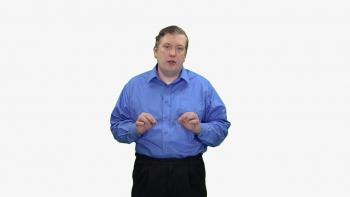
// All of them are talking about an art work, its absolutely stunning character, its force. Sometimes in a casual and cool, sometimes even in a serious and professional manner. “Normal” people or self-declared experts confide their individual evaluations to the webcam. For their praise of the work they struggle for words, they come to a halt, remain vague. Every attempt at a verbal approach towards this “absolutely amazing piece of art” seems to be inadequate; Its description remains undetermined until the end. The accounts appear fresh, spontaneous, immediate: Right on the way back from the visit at the exhibition and still in the car, from the cozy corner of the balcony or the swiveling chair in the office, the speakers formulate their unanimous positive impressions. With every sequence the inevitable urge increases—if not to see the art work in the whole with one's own eyes— to at least receive a little, concrete indication of which art work everyone is talking about. One hopes in vain: Over eight minutes TESTIMONIALS shows nothing but the simple sequence of indefinite art work reviews. Economists consider authentic consumer reviews, called testimonials, especially in the online market, as one of the most fruitful measures in marketing products and services. Its enormous effectiveness has allowed the testimonial to become a product of its own, which companies have been buying ever since, to increase the sales of their products. These fake reviews are not only produced by professional agencies but also— and to a much larger extent— by an army of independently acting individuals world-wide, for whom faking customer reviews means an extra source of income. This is exactly where Ralph Schulz' TESTIMONIALS sets in: In real life, all of the shown film-sequences are actually video-reviews ordered by the artist himself. Through the internet, Schulz sent the paid reviewer texts he had written as well as other instructions concerning the desired setting of the video. The reviewers received between 5$ and 25$ for their video, which they then made available for the artist as a download.
Thus comes to light the ironic and paradoxical framework of the video-installation TESTIMONIALS. There was no prior art work, which supposedly was the reference of the description. The Je ne sais quoi of the videos not merely acted, it is to be taken literally: “What” the reviewers are talking about—they truly do not know. Believing to be reviewing an existing product according to common logic as usual, they first and foremost produce the product, the art work, that they think they are evaluating. (Self)Ironically, producer and reviewer fall into one. In its tautological form TESTIMONIALS engages in a precise, humorous, and at the same time critical analysis of contemporary entanglements between art and the market under the modalities of the internet.
Vivien Grabowski
Berlin 2016 / Video-Projektor, HD-Player, 2 Kopfhörer (08:00 Min.)
Audiovisual Micro-Interventions for TRIBUNAL Unraveling the NSU Complex and beyond – Spoter/innen (Kulturbahnhof)

How can we change the field of the visible so that racist structures can be called out? How can (post)migrant realities and perspectives become visible and audible loudly and clearly?
Between 1999 and 2007 nine immigrants, all of them small businessmen, and one police officer were murdered in Germany. In three bomb attacks–including one at a shopping street in Cologne marked as an immigrant space–numerous people were seriously wounded. The facts of these cases remained unexplained until the so-called National Socialist Underground (NSU) exposed itself in 2011 and admitted to the crimes. To this day the series of murders and attacks has not been completely clarified. There are still open questions related to, for instance, the right-wing radical environment around the NSU, as well as to the role of the German domestic secret service (the “Verfassungsschutz”), which had numerous informants in the perpetrators’ world.
What has become clear, however, is how deeply racism is entrenched in German society. We see this very strongly in the willful ignorance of the police and security organs. For many years they have consistently investigated in wrong directions, allegedly failing to recognize racism as a motivation for the crimes. And they are still downplaying its centrality even now.
SPOTS are short audiovisual interventions into various facets of the NSU Complex. Some of them are meant to mobilize for the Tribunal. All of them address the blind spots in the process of working through the NSU Complex. They throw spotlights on the racist circumstances that make right-wing networks and their crimes possible in the first place. SPOTS regard aesthetics as political action. These aesthetics counter the dominant visual politics and their visual fixation on the perpetrators, and the media’s disinformation about the NSU complex. They reverse visibilities, represent gestures of resistance, formulate questions and accusations. And in doing so they look to initiate a wider debate in society.
http://nsu-tribunal.de
http://tribunal-spots.net
Berlin 2017 / Monitor, Computer, Maus, Tastatur
– Daniel Leander Goffin, David Priemer, Cassandra Khaw, Christian Wittmoser, Thomas Höhl, Zach Cohen (Kulturbahnhof)

SHE REMEMBERED CATERPILLARS ist ein Farbenpuzzle in aufregender Pilzpunk-Ästhetik. Das Spiel transportiert uns in eine traumgestaltwandlerische Welt der sich windenden Raupen, knallbunten Gammies und der lebenden Architektur, in der die Problematik der Rettung ihres Vaters zu einer wissenschaftlichen Frage wird.
Developer: jumpsuit entertainment UG, Daniel Leander Goffin, David Priemer, Cassandra Khaw, Christian Wittmoser, Thomas Höhl, Zach Cohen
published by Ysbryd Games
GlassBook / GlassPhone – Tilman Hornig (Kulturbahnhof)
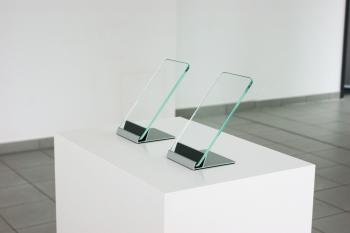
One has to correct the philosopher Quentin Meillassoux, who is one of the most vehement speculative realists of the present: real isn’t what can be expressed in formulae. De facto real s what can be calculated by computers. Where computers fail, the horizon of our objective reality also ends— everything beyond that is “merely subjective.” Only the computers of banks and stock markets materialize property. Only the digital archiving and normalization of social relations on microchips produce stable, continuous contacts. Only the recording and comparing of our data by medical computers make it possible to speak of health. In some countries, computers are already calculating the results of elections by themselves.
Because of their indispensability to modern physics, computers also define what we consider to be “the real world.”From an ontological point of view, computers—similar to Heidegger’s notion of Being— “are” not at all. Today, they are required to determine any kind of being. They, therefore, precede any kind of being. Computers “are” not, they exist as an invisible given, which penetrates everything. As a universal medium, they are similar to that which Aristotle called the diaphane, the “transparent” – an undetermined “in-between,” metaxu, which has to be formless in order to take on any form and transport all possible impressions. The significance of the computer also correlates to an image of the Stoics, the apeiron, “the in-finite,” which, being primal matter, includes the possibility of any other matter, and which, exactly because of that, has no proper qualities itself. It is therefore no accident that transparency is the ethos of our time. The absolute permeability of the computer has evolved into a measure for the organization of human relations and politics. In the face of the total permeability of the digital-diaphane primal matter, all information is equally decontextualized and deformed, transformed into mere online “content”. And being the result of this process, the content online does not contain anything, but is similarly deformed, as empty as the computer itself. First of all, content doesn’t contain anything, because without context, there is no content in the proper sense. And the computer knows only one context: itself. The majority of the information online deals with the apparatus itself. How useless is the new iPhone? Or, does Samsung ignite faster after all? By which new functions is Facebook violating our private sphere in an even more menacing way? In which crypto-currency to invest, which to sell right before the inevitable collapse? What will change when 3D-printers in children’s rooms produce firearms? McLuhan’s formula, that the medium is the message, was never more true. The “content” of the internet is the nothingness of the computer and nothing more. To gaze into an abyss of nothingness from a box seat, in colors as brilliant as the sun: this is the dream of our age.
Johannes Thumfart
Dresden 2017 / Glasobjekte, Sockel
GlassBook / GlassPhone – Tilman Hornig (Kulturbahnhof)

One has to correct the philosopher Quentin Meillassoux, who is one of the most vehement speculative realists of the present: real isn’t what can be expressed in formulae. De facto real s what can be calculated by computers. Where computers fail, the horizon of our objective reality also ends— everything beyond that is “merely subjective.” Only the computers of banks and stock markets materialize property. Only the digital archiving and normalization of social relations on microchips produce stable, continuous contacts. Only the recording and comparing of our data by medical computers make it possible to speak of health. In some countries, computers are already calculating the results of elections by themselves.
Because of their indispensability to modern physics, computers also define what we consider to be “the real world.”From an ontological point of view, computers—similar to Heidegger’s notion of Being— “are” not at all. Today, they are required to determine any kind of being. They, therefore, precede any kind of being. Computers “are” not, they exist as an invisible given, which penetrates everything. As a universal medium, they are similar to that which Aristotle called the diaphane, the “transparent” – an undetermined “in-between,” metaxu, which has to be formless in order to take on any form and transport all possible impressions. The significance of the computer also correlates to an image of the Stoics, the apeiron, “the in-finite,” which, being primal matter, includes the possibility of any other matter, and which, exactly because of that, has no proper qualities itself. It is therefore no accident that transparency is the ethos of our time. The absolute permeability of the computer has evolved into a measure for the organization of human relations and politics. In the face of the total permeability of the digital-diaphane primal matter, all information is equally decontextualized and deformed, transformed into mere online “content”. And being the result of this process, the content online does not contain anything, but is similarly deformed, as empty as the computer itself. First of all, content doesn’t contain anything, because without context, there is no content in the proper sense. And the computer knows only one context: itself. The majority of the information online deals with the apparatus itself. How useless is the new iPhone? Or, does Samsung ignite faster after all? By which new functions is Facebook violating our private sphere in an even more menacing way? In which crypto-currency to invest, which to sell right before the inevitable collapse? What will change when 3D-printers in children’s rooms produce firearms? McLuhan’s formula, that the medium is the message, was never more true. The “content” of the internet is the nothingness of the computer and nothing more. To gaze into an abyss of nothingness from a box seat, in colors as brilliant as the sun: this is the dream of our age.
Johannes Thumfart
Dresden 2017 / Glasobjekte, Sockel




